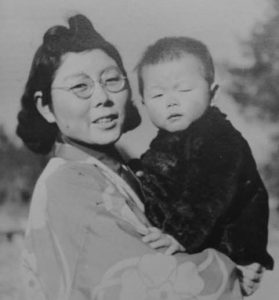Survivors’ Stories: Tomie Mito, 106, Fuchu-cho, Hiroshima―Her father died in the atomic bombing, and her unborn child was exposed
Aug. 5, 2024
106-year-old visits the site of her burnt-out home for the first time in 79 years
by Kana Kobayashi, Staff Writer
Tomie Mito, now 106 years old, lost her “favorite father who was kind” in the atomic bombing when she was 27 years old. Tomie, who was four months pregnant at the time, entered the devastated city of Hiroshima three days after the bombing, and gave birth to her eldest son, an in-utero exposed survivor, the following year. It was hard for her to remember 79 years ago, and she has lived her life without willingly sharing her experience.
On the morning of August 6, 1945, Tomie was at her parents’ home in Hatakamura village (now part of Aki Ward), where she had moved from her husband’s family home in Komachi (now part of Naka Ward) to avoid air raids. As she went outside the house, she heard the sounds of an airplane, then a “boom” roared. She and her neighbors went up the nearby mountain and saw Hiroshima in flames. Soon the wounded were being carried one after another.
Tomie, her mother, Masu, then 50, and other family members were very worried about Tomie’s father, Hoichi Anada, then 52, and her husband, Yoshio, then 37, who had not returned home from work in Hiroshima City. They were too shaken up to do anything else.
Around 9:00 p.m., they heard Hoichi’s voice saying “I’m home.” His head was so sooty that it was hard to tell which side was his face, and his clothes were torn to shreds and hanging like wakame seaweed. He said he got buried under a mud-walled storehouse near the Dobashi streetcar stop (located in present-day Naka Ward), about 700 meters from the hypocenter, but narrowly escaped death.
Two days later, Yoshio, who was a teacher at Hiroshima Higher Normal School (located in present-day Minami Ward) came home. He was exposed to the atomic bombing on the school grounds and was doing everything he could to save the students. Tomie remembers breathing a sigh of relief when they returned home alive.
However, around August 20, Hoichi fell ill in bed. Purple spots appeared all over his entire body, and he vomited a “stinking lump like fish guts” into a washbowl. He died on September 3. A doctor said, “Poison gas entered his body through the wound.”
During the war, when food was scarce, Tomie’s father often brought a lunch box made of precious rice and vegetables for Tomie from Hatakamura to Komachi. Thinking of his kind face still brings tears to Tomie’s eyes. Tomie was also exposed to the bomb’s radiation when she entered the city on August 9, walking about 10 kilometers in a single direction. The city had been reduced to ashes, and bodies covered with straw mats lay by the roadside.
There was no trace of her home, about 800 meters from the hypocenter, except for gateposts and a stone washbasin. When she found her mother-in-law’s ornamental hairpin in the smoldering ground, her heart “swelled with loneliness.”
The baby who was in Tomie’s womb was born in January 1946. Kosei, now 78 of Fuchu-cho, Hiroshima Prefecture, was a sickly child, and she always worried about him. Later studies have shown a fetus is more susceptible to the effects of radiation than adults. She recalls, “I didn’t know that at the time, and I never thought that his illness had anything to do with radiation exposure from the bomb.”
Neither Tomie nor Yoshio, who also witnessed the devastation of the central part of the city and is now deceased, ever talked about “that day” at home. However, Kosei’s sense of mission as “an atomic bomb survivor from birth” grew stronger, leading to his involvement in peace activities. At the age of 58, he took early retirement from his job as a high school English teacher. He stands in front of the Atomic Bomb Dome and works year-round as an English-speaking volunteer guide for international visitors.
Encouraged by Kosei, Tomie decided to do two things in July, and carried them out.
For the first time in 79 years, she visited the place where her home used to stand, and which she had not attempted to visit since the day of the bombing. Kosei—in her womb at the time of the atomic bombing—went along, pushing her wheelchair. “The whole area was burned to the ground,” Tomie faced her painful memory.
In addition, she shared her atomic bomb experience with the junior writers of the Chugoku Shimbun, who are junior and senior high school students, hoping to leave them with her wish of “never waging a war that might lead to the use of a nuclear weapon.” She has been interviewed by the press before, but this was the first time she spoke to a group of children.
She said, “When society is heading toward war, I want you to act with the power to repel it,” and encouraged them with the English words she learned in school about 90 years ago: “Do your best.” Tomie has also engraved the words in her heart at the age of 106.
(Originally published on August 5, 2024)











